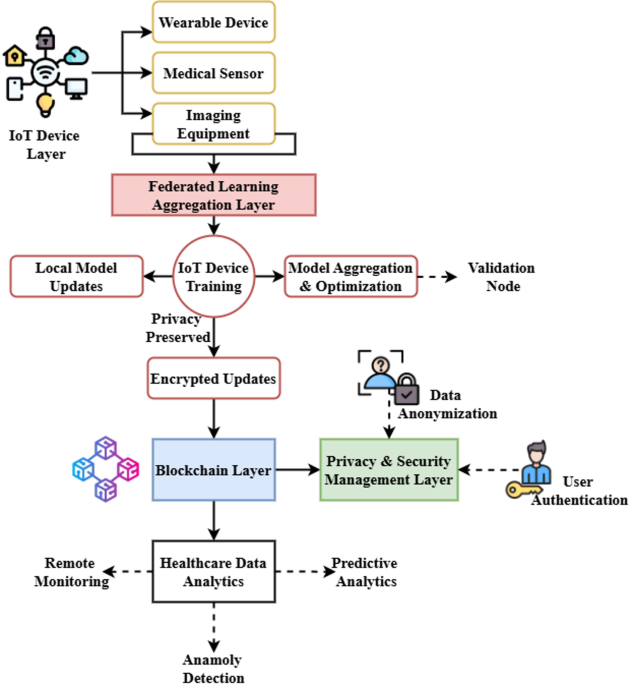
The proposed FBCI-SHS addresses critical privacy, security, and efficiency challenges in IoMT-based smart healthcare. Integrating federated learning, blockchain, and IoT ensures secure health monitoring, intrusion detection, and proactive patient care. Utilizing blockchain’s consensus methods and immutable ledger, the system greatly benefits from a decentralized environment, guaranteeing trust and transparency across federated IoT healthcare nodes. Blockchain technology makes decentralized identity management and safe aggregation of model changes possible, as opposed to public key infrastructure (PKI), which relies on centralized certificate authorities and is susceptible to problems like certificate revocation or single points of failure. In the FBCI-SHS architecture, blockchain is used for more than just authentication and encryption; it also keeps a verifiable and immutable record of access logs, model update hashes, and federated learning transactions. In addition, PKI systems aren’t built to automate policy enforcement and anomaly reactions; smart contracts can. Therefore, although PKI might provide the groundwork for secure communication, blockchain’s distributed trust and programmability qualities make it more suited to dynamic, large-scale healthcare settings with several stakeholders.
Secure and scalable system integration
The proposed FBCI-SHS architecture uses blockchain and federated learning to solve IoMT privacy, security, and regulatory issues. This solution decentralizes patient data, promotes medical data governance compliance, and prevents data confidentiality breaches.
Figure 1 shows a federated learning, blockchain, FBCI-SHS, architectural framework based on IoMT technologies. The framework has many layers addressing different but equally relevant safe and efficient healthcare delivery issues. The IoT Layer connects several medical sensors and devices to gather real-time patient data. This data is processed at the Federated Learning Aggregation Layer for local processing while protecting user privacy and avoiding storage security problems associated with centralized databases. A global model makes predictive precision and preventative health monitoring possible. It boosts credibility by protecting transactions with decentralized, immutable storage and guaranteeing data integrity.

Architecture of sustainable healthcare.
This increased privacy protection and security management makes protecting sensitive patient data and complying with laws easier. Health data analytics may save lives by managing healthcare, detecting illnesses, and preventing network infiltration using pooled information. To guarantee authenticity and traceability, the FBCI-SHS framework uses cryptographic keys unique to each IoT device to sign model updates once trained locally. The signed changes are sent to the blockchain network, where smart contracts check the authenticity and validity of each model by comparing the hashes given with anticipated forms and confirming digital signatures. A change must pass this validation procedure to be posted to the blockchain ledger. A predetermined consensus technique, such as Practical Byzantine Fault Tolerance (PBFT), certifies the data’s validity and allows for safe aggregation after enough validated changes have been logged. Additionally, the blockchain maintains the immutable audit trail of all modifications, which helps traceability and prevents tampering. This layered approach ensures smart healthcare systems’ security, interoperability, and economy.
$$\:\partial\:{\propto\:}^{{\prime\:}}:\to\:Ns\left[a{p}^{{\prime\:}}-sm\right]+2vd\left[sw-qxa{\prime\:}{\prime\:}\right]-klo\left[js{r}^{{\prime\:}{\prime\:}}\right].$$
(1)
The variable vd encompasses factors \(\:\partial\:{\propto\:}^{{\prime\:}}\) that have an influence \(\:Ns\left[a{p}^{{\prime\:}}-sm\right]\) on illness detection accuracy and proactive healthcare management. Equation 1 ∂ indicates the confidentiality of data (\(\:2vd\left[sw-qxa{\prime\:}{\prime\:}\right]\)), Ns reflects computer safety aspects (intrusion detecting efficiency of \(\:klo\left[js{r}^{{\prime\:}{\prime\:}}\right]\)).
$$\:{t}_{r}Ed:\to\:nX\left[s-8b{w}^{{\prime\:}{\prime\:}}\right]+Bas\left[si-sl{w}^{{\prime\:}{\prime\:}}\right]-vs\left[a-nwq{a}^{{\prime\:}{\prime\:}}\right].$$
(2)
The Eq. 2 is a representation of the historical reliability \(\:{t}_{r}Ed\) and efficiency (\(\:X\left[s-8b{w}^{{\prime\:}{\prime\:}}\right]\)) of the FBCI-SHS infrastructure in the context of managing healthcare operations. The variable \(\:Bas\left[si-sl{w}^{{\prime\:}{\prime\:}}\right]\) is used to represent network execution metrics, the variable \(\:vs\left[a-nwq{a}^{{\prime\:}{\prime\:}}\right]\) is used to address blockchain-assisted security.
$$\:{n}_{f}rd:\to\:Ma\left[sz-8v{w}^{{\prime\:}{\prime\:}}\right]-Cs\left[ew-a{m}^{{\prime\:}{\prime\:}}\right]+\:Ks{j}^{{\prime\:}{\prime\:}}\left[xw{q}^{{\prime\:}{\prime\:}}\right].$$
(3)
In the Eq. 3, the variable \(\:{n}_{f}rd\) represents the accuracy of ML in predicting illnesses, \(\:Ma\left[sz-8v{w}^{{\prime\:}{\prime\:}}\right]\) represents the cost savings that are gained \(\:Ks{j}^{{\prime\:}{\prime\:}}\left[xw{q}^{{\prime\:}{\prime\:}}\right]\) efficient processing of information. By guaranteeing that the framework can deliver healthcare solutions that are accurate, cost-effective, and secure, this equation contains the framework’s capacity.
$$\:{\forall\:}_{d}s\left[ju-a{m}^{{\prime\:}{\prime\:}}\right]:\to\:kn\left[s-ne{w}^{{\prime\:}{\prime\:}}\right]+8Vs\left[w-9vw{q}^{{\prime\:}{\prime\:}}\right].$$
(4)
The Eq. 4 contains universal confidentiality of information (\(\:{\forall\:}_{d}s\)) within the context of the FBCI-SHS. The variable \(\:\left[ju-a{m}^{{\prime\:}{\prime\:}}\right]\) reflects the sharing of knowledge \(\:8Vs\left[w-9vw{q}^{{\prime\:}{\prime\:}}\right]\) that is made possible by federated learning, and the variable \(\:kn\left[s-ne{w}^{{\prime\:}{\prime\:}}\right]\) measures the system’s capacity to scale. This equation demonstrates the framework’s capacity to safely handle and analyze data scattered across several locations.
$$\:{u}_{v}rD:\to\:nS\left[Av-a{m}^{{\prime\:}{\prime\:}}\right]+9B\left[Sx-wm{q}^{{\prime\:}{\prime\:}}\right]-cs{w}^{{\prime\:}{\prime\:}}.$$
(5)
The FBCI-SHS framework takes into account both the user value (\(\:nS\left[Av-a{m}^{{\prime\:}{\prime\:}}\right]\)) and the distribution of resources \(\:{u}_{v}rD\)). Network scalability for medical device accommodation is denoted by \(\:9B\left[Sx-wm{q}^{{\prime\:}{\prime\:}}\right]\), security upgrades enabled by blockchain are represented by \(\:cs{w}^{{\prime\:}{\prime\:}}\), and computational efficiency. This equation highlights the framework’s emphasis on healthcare benefits by guaranteeing safe, scalable, and resource-efficient procedures. The inclusion of differential privacy was based on the assumption that all participating IoT devices and edge nodes acted honestly but curiously, following the federated learning protocol and maybe trying to deduce information from shared model changes. The communication network was deemed stable since no scenarios involving catastrophic delay, packet loss, or node failure were simulated.
It was assumed that all devices had synced clocks to ensure that federated rounds and blockchain consensus could be executed on time. Similarly, the simulation did not consider node turnover or dynamic reconfiguration; it assumed a constant number of devices (say, 100 nodes). Even though the data distribution among edge nodes was not uniform, it was nevertheless believed to be balanced enough to prevent training bias. There was zero tolerance for node-to-node coordination to poison models or damage the blockchain (e.g., 51% of attacks).
Patient monitoring methods of the FBCI-SHS framework are shown in Fig. 2a. Medical sensors linked to the IoT let physicians monitor patients from their homes. Blockchain technology ensures integrity and privacy, ensuring the data is delivered safely. Healthcare experts access the encrypted data via certified channels to make snap choices. Federated learning lets the system handle data in real-time without violating privacy. Thus, proactive healthcare management may be achieved without sacrificing data security and regulatory compliance.
$$\:{de}_{f}v:\to\:l{I}^{{\prime\:}}\left[Xs{q}^{{\prime\:}{\prime\:}}+9v{e}^{{\prime\:}{\prime\:}}\right]-Vs\left[se-s{n}^{{\prime\:}{\prime\:}}\right]+\:9Vs{w}^{{\prime\:}{\prime\:}}.$$
(6)
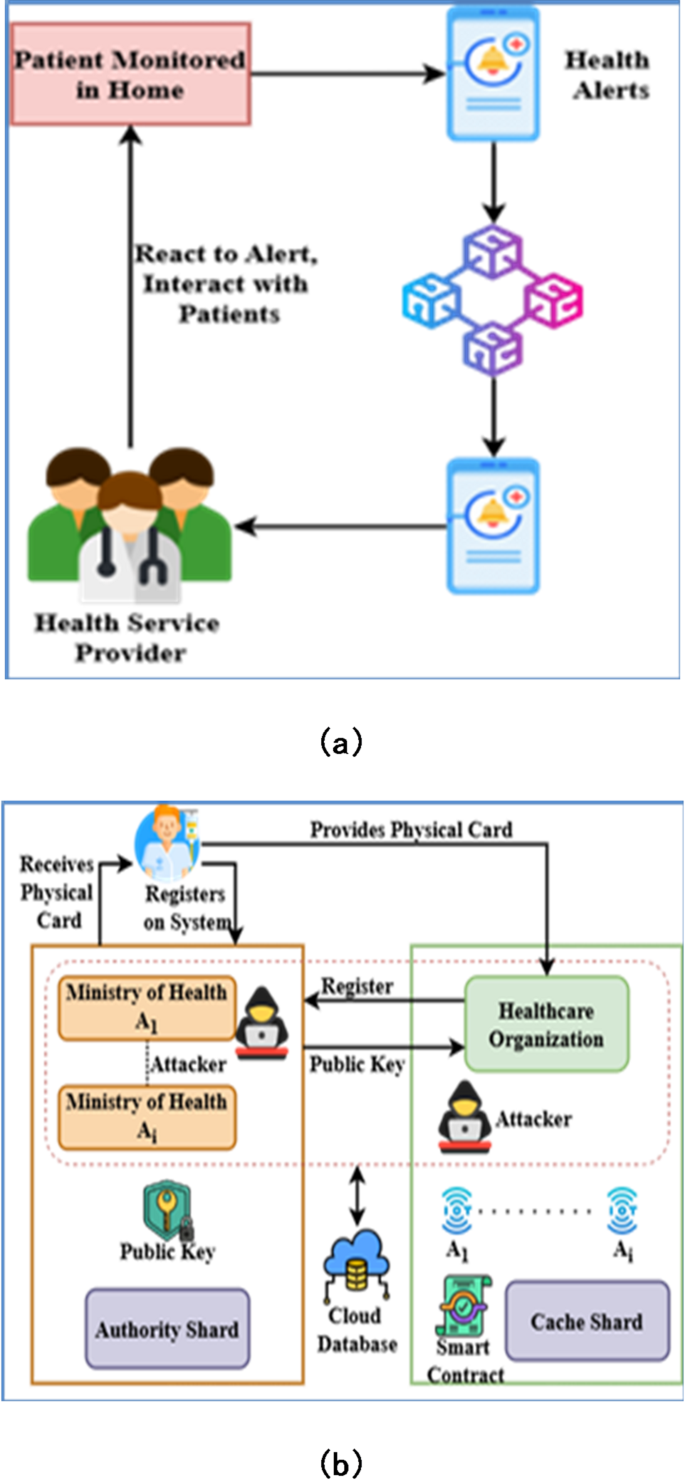
(a) Secure health monitoring and data sharing. (b) Decentralized sharing for secure data management.
In the FBCI-SHS framework, the data efficacy (\(\:{de}_{f}v\)) and value (\(\:l{I}^{{\prime\:}}\left[Xs{q}^{{\prime\:}{\prime\:}}+9v{e}^{{\prime\:}{\prime\:}}\right]\)) are represented by the equation. Data security and processing speed are measured by \(\:Vs\left[se-s{n}^{{\prime\:}{\prime\:}}\right]\) and \(\:9Vs{w}^{{\prime\:}{\prime\:}}\), localized intelligence is represented. Effective and safe healthcare data management is ensured by this framework’s capability to balance effectiveness, protection, and scalability, as shown by Eq. 6.
$$\:{dr}_{v}b:\to\:li\left[sf-9b{w}^{{\prime\:}{\prime\:}}\right]+Ksa\left[ds-uy{w}^{{\prime\:}{\prime\:}}\right]-nsq{a}^{{\prime\:}{\prime\:}}.$$
(7)
In the FBCI-SHS architecture, Eq. 7 represents the efficiency of the blockchain (\(\:Ksa\left[ds-uy{w}^{{\prime\:}{\prime\:}}\right]\)) and the dependability of the data (\(\:{dr}_{v}b\)). In this context, \(\:li\left[sf-9b{w}^{{\prime\:}{\prime\:}}\right]\) stands for secure federated educational systems at the local level, \(\:nsq{a}^{{\prime\:}{\prime\:}}\) for confidentiality. The capability of the framework to provide efficient, safe, and dependable processing and monitoring of healthcare data is shown by this equation.
Figure 2b shows the Shard technique inside FBCI-SHS architecture: Data governance and access control are managed by the Authority Shard. This is maintained by government agencies such as the Ministry of Health. Healthcare organizations will manage the Cache Shard. Blockchain-based communication between shards will ensure secure and efficient data processing. This structure improves data integrity and confidentiality and prevents unauthorized access, a major concern in managing sensitive healthcare data.
$$\:{n}_{v}d:\to\:Ns\left[w-9v{w}^{{\prime\:}{\prime\:}}\right]+iw\left[q\right]-jw\left[kiy-aq\right]+je{q}^{{\prime\:}{\prime\:}}.$$
(8)
In the FBCI-SHS framework, the Eq. 8 stands for data efficiency (\(\:Ns\left[w-9v{w}^{{\prime\:}{\prime\:}}\right]\)) and network value (\(\:{n}_{v}d)\). Network safety and flexibility are represented by \(\:iw\left[q\right]\), intelligent workflow integration is denoted by \(\:jw\left[kiy-aq\right]\), computational load optimization is addressed by \(\:je{q}^{{\prime\:}{\prime\:}}\), and equitable resource allocation. Equation highlights the framework’s capacity to optimize network functioning, improve workflow intelligence, and process data.
$$\:{m}^{f}r\left[v-s{m}^{{\prime\:}{\prime\:}}\right]:\to\:ls\left[w-nq{w}^{{\prime\:}{\prime\:}}\right]+nd\left[rwa{q}^{{\prime\:}{\prime\:}}-ndq\right].$$
(9)
Inside the FBCI-SHS framework, Eq. 9 stands for the machine intelligence capabilities (\(\:{m}^{f}r\)) and dependability (\(\:\left[v-s{m}^{{\prime\:}{\prime\:}}\right]\)). Network fluctuations in distributing resources and anomaly detection are captured by \(\:ls\left[w-nq{w}^{{\prime\:}{\prime\:}}\right]\) and localized system resilience and safety are denoted by \(\:nd\left[rwa{q}^{{\prime\:}{\prime\:}}-ndq\right]\). This equation shows that the framework uses ML to make healthcare systems more reliable.
Advanced intrusion and disease detection
Having an Intrusion Detection System (IDS) in place allows for a 97.16% success rate in accurately identifying network threats. At the same time, the system detects diseases with a 96.42% accuracy rate, allowing clinicians to foresee potential dangers to their patient’s health and suggest treatments promptly.
Figure 3 shows the Schematic of the proposed FBCI-SHS Federated Blockchain-IoT Framework for Sustainable Healthcare Systems. The Health Edge is a central server that coordinates federated learning operations and ensures secure aggregation and model updates. Data collection from IoT devices controlled by patients is done in a decentralized manner. In this sense, patients’ health may be continuously watched in real-time without violating their rights. Patients, IoT devices, and healthcare providers center the network; blockchain technology guarantees unchangeable information and secure transactions. Every node in the global learning model does not broadcast personally identifiable patient information while involved. The design prioritizes privacy, encourages ownership, and ensures compliance with regulations. Health Edge equips medical professionals with proactive management tools that aid in detecting diseases and incursions. By working together, blockchain and federated learning build a smart healthcare ecosystem that is effective, secure, and robust; this, in turn, allows for high-performance prediction and proactive management.
$$\:{jo}_{e}f\left[s-bw{q}^{{\prime\:}{\prime\:}}\right]:\to\:jds\left[6ge{w}^{{\prime\:}{\prime\:}}\right]+od\left[s-ns{q}^{{\prime\:}{\prime\:}}\right]-sn{w}^{{\prime\:}{\prime\:}}.$$
(10)
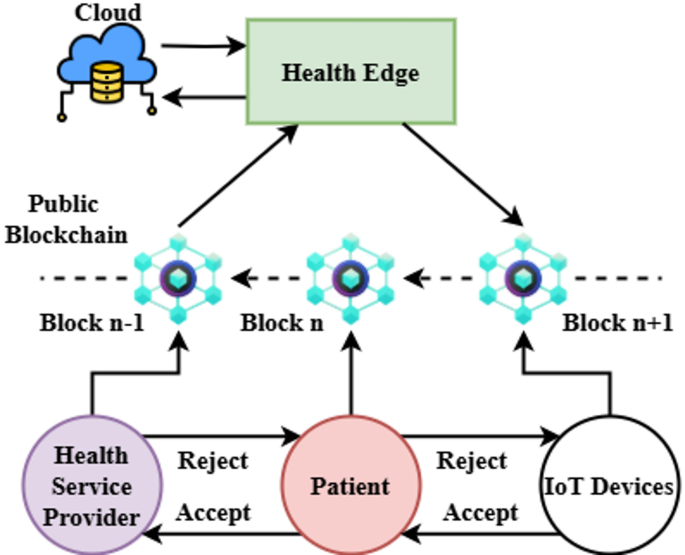
Federated Blockchain-IoT integration for healthcare.
The FBCI-SHS framework emphasizes the importance of scalability \(\:d\left[s-ns{q}^{{\prime\:}{\prime\:}}\right]\) and joint data security \(\:sn{w}^{{\prime\:}{\prime\:}}\), while operational information management \(\:\left[s-bw{q}^{{\prime\:}{\prime\:}}\right]\) and communication synchronization are represented by \(\:{jo}_{e}f\) and system-wide workload optimization is taken into consideration by \(\:jds\left[6ge{w}^{{\prime\:}{\prime\:}}\right]\). Equation 10 demonstrates resources, handles data securely, and keeps processes running smoothly.
$$\:{p}_{d}\left[ui-s{n}^{{\prime\:}{\prime\:}}\right]*g\left[ns{w}^{{\prime\:}{\prime\:}}+s{j}^{{\prime\:}}\right]:\to\:\:lS\left[xwq-an{f}^{{\prime\:}{\prime\:}}\right]+\:Js\left[s-8b{v}^{{\prime\:}{\prime\:}}\right].$$
(11)
Within the FBCI-SHS framework, Eq. 11 (\(\:{p}_{d}\)) describes the prediction dynamics and data interface (\(\:\left[ui-s{n}^{{\prime\:}{\prime\:}}\right]\)). \(\:g\left[ns{w}^{{\prime\:}{\prime\:}}+s{j}^{{\prime\:}}\right]\) guarantees safe, scalable blockchain access, \(\:Js\left[s-8b{v}^{{\prime\:}{\prime\:}}\right]\) concentrates on localized system optimization, and\(\::\to\:\:lS\left[xwq-an{f}^{{\prime\:}{\prime\:}}\right]\) symbolizes the integration of the entire world and joint data processing. This equation shows the predictive capabilities of the framework for proactive care administration.
$$\:{k}_{f}e\left[kui-a{n}^{{\prime\:}{\prime\:}}\right]:\to\:Js\left[s-bn{r}^{{\prime\:}{\prime\:}}\right]+Bs\left[jw-na{q}^{{\prime\:}{\prime\:}}\right].$$
(12)
Equation 12 in the FBCI-SHS paradigm specifies the important features \(\:{k}_{f}e\)) and the efficiency (\(\:\left[kui-a{n}^{{\prime\:}{\prime\:}}\right]\)). The sentence means that \(\:Js\left[s-bn{r}^{{\prime\:}{\prime\:}}\right]\) symbolizes the secure handling of data and integration of systems via blockchain, and \(\:Bs\left[jw-na{q}^{{\prime\:}{\prime\:}}\right]\) is a representation of resources. This equation highlights the need to improve functional reliability, safety, and scalability for proactive healthcare solutions to succeed.
$$\:{k}_{f}e\left[bsle-m{a}^{{\prime\:}{\prime\:}}\right]:\to\:msr\left[s-7v{f}^{{\prime\:}{\prime\:}}\right]+Js\left[4v-as{m}^{{\prime\:}{\prime\:}}\right].$$
(13)
The equation outlines the essential features (\(\:msr\left[s-7v{f}^{{\prime\:}{\prime\:}}\right]\)) and performance \(\:{k}_{f}e\) of the FBCI-SHS system. \(\:\left[bsle-m{a}^{{\prime\:}{\prime\:}}\right]\) stands for the dependability and efficiency of the system when subjected to different healthcare loads, \(\:Js\left[4v-as{m}^{{\prime\:}{\prime\:}}\right]\) for the safe transfer of data and the effective distribution of resources. Functionality, assurances, and scalability are all carefully balanced in this equation, guaranteeing safe and effective healthcare administration.
Figure 4 shows the design of a Fog Cloud Agent that allows for effective and safe healthcare monitoring using the IoT. The Fog Cloud Agent is a middleman between medical applications and decentralized IoT modules (iTM 1, iTM 2, iTM 3), ensuring real-time replies, privacy, and smooth data processing. Various iTMs that focus on distinct features of health care are available; they may relate to e-hospital services and can even provide vital indicators such as ECG and blood pressure. So, the patient’s data isn’t directly fed into a centralized server for preserving their privacy. The model here utilizes federated learning, whereby it is trained across the entire world. It is known to reduce the healthcare application response times and minimize latency by compiling and interpreting local insights from iTMs. The process enables data security and integrity to be improved due to the adoption of blockchain technology. This healthcare ecosystem, designed with a scalable and decentralized architecture, achieves high efficiency and privacy requirements and stands out in proactive management and detection of illness and intrusions.
$$\:{\partial\:}_{j}i\left[{\propto\:}^{{\prime\:}}-v{r}^{{\prime\:}{\prime\:}}\right]:\to\:ns\left[r-vs{w}^{{\prime\:}{\prime\:}}\right]+jD\left[R-7xs{Q}^{{\prime\:}{\prime\:}}\right]-ufv{\prime\:}{\prime\:}.$$
(14)
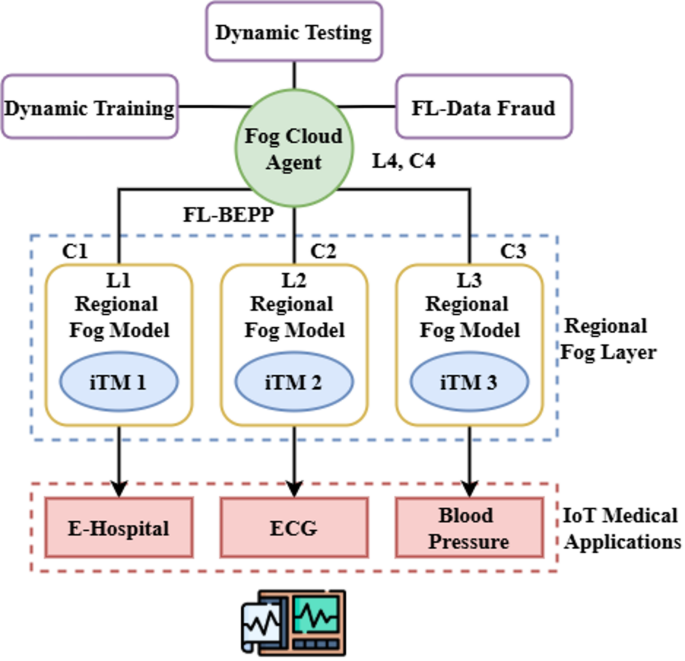
Fog-based IoT integration for decentralized healthcare systems.
The FBCI-SHS framework’s incremental improvement (\(\:{\partial\:}_{j}i\)) and intelligence \(\:\left[{\propto\:}^{{\prime\:}}-v{r}^{{\prime\:}{\prime\:}}\right]\)) are represented by the Eq. 14. Network flexibility \(\:ns\left[r-vs{w}^{{\prime\:}{\prime\:}}\right]\) and safety are represented by \(\:jD\left[R-7xs{Q}^{{\prime\:}{\prime\:}}\right]\) and robust healthcare management is captured by \(\:ufv{\prime\:}{\prime\:}\). Highlighting the framework’s ongoing development for safe and efficient healthcare monitoring deals with optimizing systems and computational efficiency.
$$\:{i}_{f}\left[si-be{q}^{{\prime\:}{\prime\:}}\right]*:\to\:\:mS\left[ju-s{m}^{{\prime\:}{\prime\:}}\right]+\:bs\left[w-8v{a}^{{\prime\:}{\prime\:}}\right].$$
(15)
The FBCI-SHS framework’s interaction ability (\(\:{i}_{f}\)) and data consistency (\(\:mS\left[ju-s{m}^{{\prime\:}{\prime\:}}\right]\)) are represented by the equation. \(\:\left[si-be{q}^{{\prime\:}{\prime\:}}\right]\) signifies scalability and system adaption driven by ML, whereas \(\:bs\left[w-8v{a}^{{\prime\:}{\prime\:}}\right]\) emphasizes safe access to the blockchain and data protection.
$$\:rv\left[f-b{w}^{{\prime\:}{\prime\:}}\right]:\to\:ndr\left[s-8v{w}^{{\prime\:}{\prime\:}}\right]+fr\left[s-8vw{q}^{{\prime\:}{\prime\:}}\right]-ns{w}^{{\prime\:}{\prime\:}}.$$
(16)
The FBCI-SHS framework’s capabilities (\(\:rv\)) and reliability factor \(\:f-b{w}^{{\prime\:}{\prime\:}}\)) are represented by the above Eq. 16. Network data availability \(\:ns{w}^{{\prime\:}{\prime\:}}\) and safety are denoted by \(\:ndr\left[s-8v{w}^{{\prime\:}{\prime\:}}\right]\)and fault resilience and adaptability in system performance are denoted by \(\:fr\left[s-8vw{q}^{{\prime\:}{\prime\:}}\right]\).
$$\:{k}_{et}\ll\:nr-s{n}^{{\prime\:}{\prime\:}}\gg\::\to\:\:Ns\left[nju-a{n}^{{\prime\:}{\prime\:}}\right]+\:bsew\left[d-bq{a}^{{\prime\:}{\prime\:}}\right].$$
(17)
Key efficiency (\(\:{k}_{et}\) and reliability in networks \(\:nr-s{n}^{{\prime\:}{\prime\:}}\) are both represented in the FBCI-SHS architecture by equality. \(\:Ns\left[nju-a{n}^{{\prime\:}{\prime\:}}\right]\) represents the scalability and security of the network, while \(\:bsew\left[d-bq{a}^{{\prime\:}{\prime\:}}\right]\) represents safe information exchange.
Evaluation of proactive healthcare impact
The system’s proactive healthcare management is made possible using IoMT sensors, as shown by the 98.37% increase in early intervention capabilities. By improving patient quality of life and guaranteeing sustainable and interoperable healthcare services, the assessment proves that FBCI-SHS is effective.
Figure 5 shows the Federated Blockchain-IoT Protecting patient privacy and enabling safe data gathering is the Sustainable Healthcare System (FBCI-SGS) goal, which includes medical IoT devices, patient sensors, and wearables in this ecosystem. Internet of Things (IoT) devices and wearables provide real-time data on vital signs to the localized edge components. Its edge components comprise a local Federated Learning (FL) model, storage, and an Intrusion Detection System (IDS). Thanks to cross-device collaboration and learning, this architecture in local FL keeps data secure and decentralized. Edge storage offers short-term, secure storage of collected data, while intrusion detection systems improve security by identifying any network breach. This design facilitates real-time decision-making by giving doctors useful patient health data. Health care service is further improved by the ability to take preventative measures. The system’s connectivity with the Internet and federated learning allows it to achieve great efficiency, privacy, and security.
$$\:{\tau\:}_{\sigma\:}\rho\:\vartheta\:\left[\pi\:\tau\:{\alpha\:}^{{\prime\:}}-dn{s}^{{\prime\:}{\prime\:}}\right]:\to\:bS\left[w-8v{q}^{{\prime\:}{\prime\:}}\right]+ndr\left[s-bn{q}^{{\prime\:}{\prime\:}}\right].$$
(18)
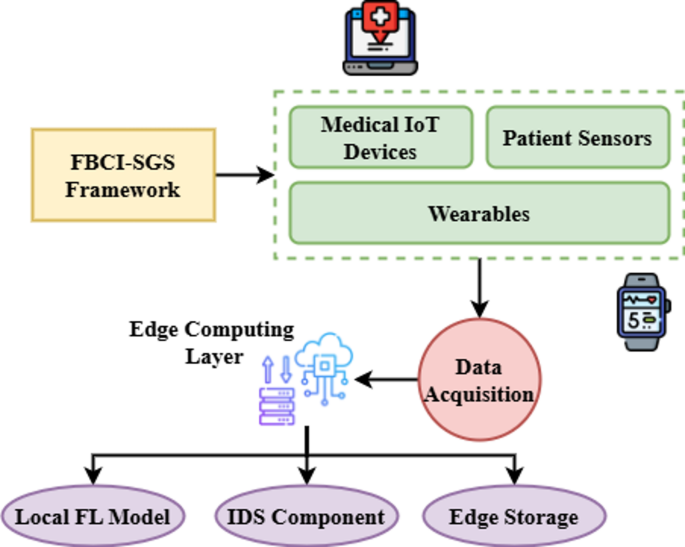
Proposed method of federated Blockchain-IoT framework for sustainable healthcare systems.
This Eq. 18 represents the FBCI-SHS framework’s dynamic assessment (\(\:bS\left[w-8v{q}^{{\prime\:}{\prime\:}}\right]\)) and reliability of data (\(\:{\tau\:}_{\sigma\:}\rho\:\vartheta\:\)). \(\:\left[\pi\:\tau\:{\alpha\:}^{{\prime\:}}-dn{s}^{{\prime\:}{\prime\:}}\right]:\to\:\)) stands for the blockchain’s safekeeping and effective data transfer, while \(\:ndr\left[s-bn{q}^{{\prime\:}{\prime\:}}\right]\) is concerned with the dependability and safety of network data.
$$\:{\partial\:}_{ns};\left[nj{s}^{{\prime\:}}-nr\right]:\to\:Ns\left[we-8b{r}^{{\prime\:}{\prime\:}}\right]+nsw\left[nq-a{m}^{{\prime\:}{\prime\:}}\right].$$
(19)
In the FBCI-SHS framework, the Eq. 19 stands for the small improvement (\(\:{\partial\:}_{ns};\left[nj{s}^{{\prime\:}}-nr\right]\)) in network reliability and security (\(\:Ns\left[we-8b{r}^{{\prime\:}{\prime\:}}\right]\)).
$$\:{\tau\:}_{\rho\:}\tau\:\ll\:nj-ge{w}^{{\prime\:}{\prime\:}}\gg\::\to\:\:ns\left[z-ve{q}^{{\prime\:}{\prime\:}}\right]+\:jd\left[f-bs{q}^{{\prime\:}{\prime\:}}\right].$$
(20)
In the FBCI-SHS framework, Eq. 20 represents both the changing efficiency (\(\:nj-ge{w}^{{\prime\:}{\prime\:}}\gg\::\to\:\:\)) and the system’s security (\(\:{\tau\:}_{\rho\:}\tau\:\)). Joint processing of information and securing the blockchain relies on storage are the main areas of attention for \(\:ns\left[z-ve{q}^{{\prime\:}{\prime\:}}\right]\), while network reliability and efficacy are represented by \(\:jd\left[f-bs{q}^{{\prime\:}{\prime\:}}\right]\). Figure 6 shows the schematic diagram mapping equations to framework components.
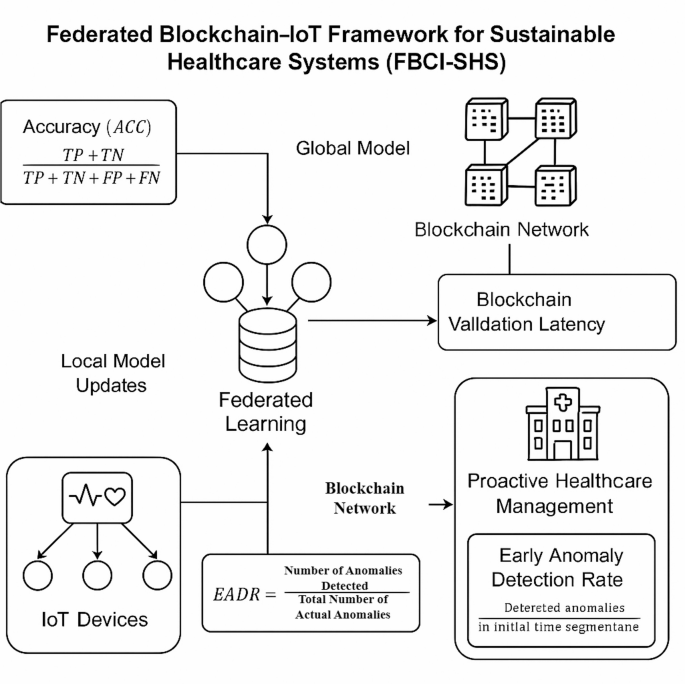
Schematic diagram mapping equations to framework components.
Algorithm 1 shows the pseudocode of the Federated Blockchain-IoT Framework for Sustainable Healthcare Systems (FBCI-SHS).
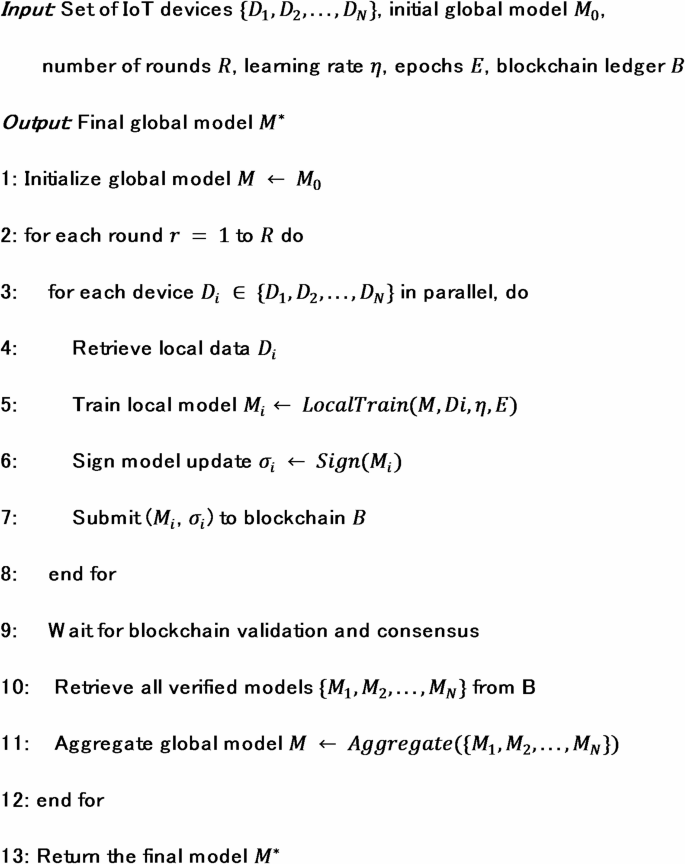
Federated Blockchain-IoT framework for sustainable healthcare systems (FBCI-SHS).
link





